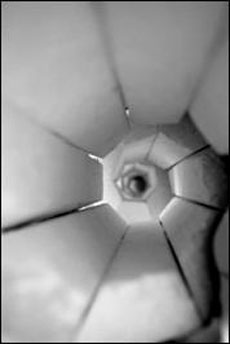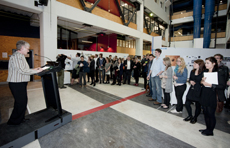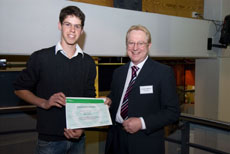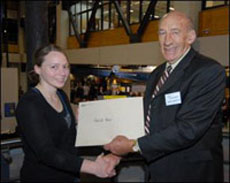Closing the loops
View previous Closing the Loop projects by students in the Wellington School of Architecture and learn how these projects work to utilise waste.
Introduction

Materials used in buildings constitute between 40-50% of the world's total material flows and a similar proportion of solid waste flows. Waste from construction and demolition activities is at least 30% of total waste in New Zealand. Only very small amounts of waste building materials from construction and demolition / deconstruction are re-used or recycled in New Zealand.
These practices are not sustainable. We will need to find ways to 'close the loops' in terms of how we use materials and move from a linear cradle to grave mentality to a more cyclic cradle to cradle approach beginning at the design stage.
One way to do this is to utilise waste as the raw material source in the production of new building materials. This avoids the use of more new materials and stops the dumping of old ones.
This idea is the focus of the Closing the Loops project where students focus on problem wastes identified by local councils and waste minimisation organisations around the country and create new building materials or products.
2010 Closing the loops in the built environment
Course Coordinator and Lecturer: Maibritt Pedersen Zari
Tutors: Nigel Case (Lighthouse Architects), Joe Nicholls (Architect) and Sarah Adams

The exhibition of student work was opened by Member of Parliament Gareth Hughs. Students were awarded prizes by Winstone Wallboards and Porirua City Council. The opening night - Celebrating Sustainability - was shared with the prize giving of the Benson-Cooper Sustainability Awards, the FirstLight Solar Decathlon entry from the school and the revealing of the Faculty's own Living Wall.
2009 Closing the loops in the built environment
Course Coordinator and Lecturer: Maibritt Pedersen Zari
Tutors: Nigel Case (Lighthouse Architects) and Robert Ferris
The exhibition of student work, sponsored by Winstone Wallboards was opened by the Mayor of Porirua Jenny Brash. Students were awarded prizes by WasteMINZ, Porirua City Council and Winstone Wallboards. The opening night - Celebrating Sustainability - was shared with the prize giving of the Benson-Cooper Sustainability Awards.
2008 Closing the loops in the built environment
Course Coordinator and Lecturer: Maibritt Pedersen Zari
Tutors: Nigel Case (Lighthouse Architects), Tim Wigmore (Unless Design), Joe Nicholls (Architect)
The exhibition of student work, sponsored by Winstone Wallboards was opened by the Mayor of Porirua Jenny Brash. Students were awarded prizes by WasteMINZ, Porirua City Council and Winstone Wallboards. The opening night - Celebrating Sustainability - was shared with the prize giving of the Benson-Cooper Sustainability Awards.
2007 Closing the loops in the built environment
Course Coordinator and Lecturer: Maibritt Pedersen Zari
Tutors: Nigel Case (Lighthouse Architects), Karl Wakelin (Argest / Stephenson Turner Architects), Richard Moore (Polyplace)

The exhibition of student work, sponsored by Winstone Wallboards was opened by the Minister of Parliament Nandor Tanczos.
Students were awarded prizes by WasteMINZ and Winstone Wallboards. Porirua City Council also awarded a scholarship for a student to investigate Waste Minimalisation in the built environment in more depth. This was won by Masters Student Pamela Bell.
2006 Closing the loops in the built environment
Course Coordinator and Lecturer: Maibritt Pedersen Zari
Tutors: Matthew ter Borg (Architect), Richard Wright (Aonui Architecture Ltd) and Chantelle Keane (Senior Student).

The exhibition of student work, sponsored by Zerowaste Trust New Zealand was opened by the Minister for Building Issues, Clayton Cosgrove. Students were awarded prizes by WasteMINZ and Zerowaste Trust New Zealand. Prize winning students Katrina Tamaira and Robert Alexander appeared on the Good Morning TV show to talk about their work.
2005 Tackling the plasterboard waste problem
Course Coordinator and Lecturer: Maibritt Pedersen Zari
Tutor: Andrew Alcorn. School of Architecture
Marion Hobbs, then Minister for the Environment opened the exhibition of the work at the lively opening night. Winstone Wallboards awarded three prizes to the best work, judged for its potential for resource conservation, ingenuity and refinement. WasteMINZ who have supported the course for a number of years awarded the prize for best report. The work was also exhibited at the 2005 WasteMINZ conference.
2004 Addressing the C&D waste problem
Course Coordinator and Lecturer: Associate Professor John Storey
Tutors: Nigel Case (Gerald Parsonson Architect) and Richard Wright (Aonui Architecture Ltd)
An exhibition of the work was held at the School of Architecture and was opened by the then Mayor of Wellington Kerry Prendergast. The exhibition was also shared by Trash Palace and Poly Palace, represented by Richard Moore, Enviromart Co-ordinator, as well as the Greater Wellington Regional Council, Ministry for the Environment and WasteMINZ. They all had their own educational exhibits and promotional displays providing information on what they are doing to help address the issues surrounding C&D waste. The Waste Management Institute of New Zealand (WasteMINZ) provided a prize for the top student, awarded to Michael Stonyer for his recycled tyre flooring tile.
2003 New designs using building waste materials
Course Coordinator: Associate Professor John Storey
Tutors: Maibritt Pedersen (School of Architecture) and Carolyn Hill (Barry Millage Architects Ltd)
The Waste Management Institute of New Zealand (WasteMINZ) provided a prize for the top student, judged to be Stephanie Livick who designed the 'Gibrix' system after a rigorous and thorough design, development and research process. Work was exhibited at the Architecture School in late April 2003 and the best work was also exhibited at the Porirua 'Trash Palace' in May.
